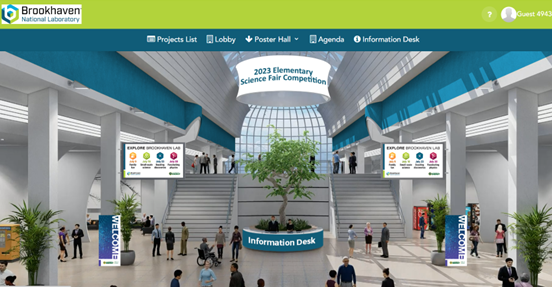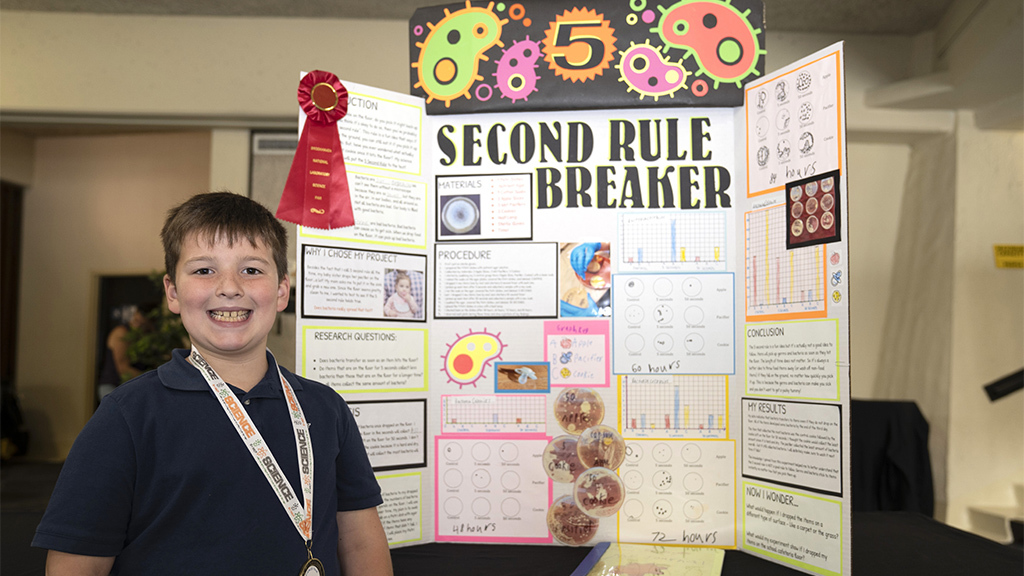Brief
Transition to Virtual Judging for In-Person Elementary School Science Fairs
“You work for Brookhaven National Laboratory? I was there in second grade when I won the science fair!” This interaction where strangers recognize the logo for Brookhaven National Laboratory (BNL) has become a regular occurrence. As one of the science fair coordinators, I have always enjoyed these encounters. Many of these participants are well into their adulthood by the time I cross paths with them, but they still recall the excitement of visiting the laboratory, sharing their project with the community, and joining the other participants on stage during the awards ceremony.
The BNL Elementary School Science Fair is a unique competition. It is only open to K–6 students who have already won their school science fair. Most large-scale science fairs are geared toward secondary students grade 7 and up. While our competitors may be asking simple questions (such as “Are Permanent Markers Really Permanent?”), this competition encourages students to use the scientific method or the engineering design process to form a hypothesis, run trials, collect data, and determine a conclusion. For many participants and their families, the BNL Science Fair is one of the few opportunities where they can visit a national laboratory. The excitement from the student participants and their families is palpable, as they look forward to seeing the lab for the first time.
BNL Suffolk County Science Fair
Prior to 2020, K–6 grade Suffolk County students who had already won their school science fair were invited to compete in the BNL Science Fair. School officials registered the students via an online form. During one eight-hour day, the Office of Educational Programs (OEP) (the host department of the BNL Science Fair), welcomed the students and their families, set up the projects, organized judging teams of BNL staff and local educators, judged the projects, and distributed awards through seven grade level–specific ceremonies. This model required the contest coordinators to perform all of these tasks in a very short period of time. To run efficiently, it necessitated over 50 volunteers for the judging alone. Students were not present during judging; they were asked to leave while volunteers judged all of the projects. Not only did the experience feel rushed for the judges, but the students and families had limited interaction with laboratory staff, volunteers, and BNL’s incredible science.

In 2020, 2021, and 2022, OEP could not host the typical exciting in-person event due to COVID-19. Instead, we held the contests virtually where schools could register their winning students, submit pictures of the project, and be judged virtually. This presented a unique opportunity to the participants; they were able to share their science with the community in a safe manner. This transition to virtual judging required a new judging system as well as a website to host the projects. Flickr and Google Sites were options, but eventually the department used vFairs, a virtual conference platform that allowed for a more interactive environment for the projects to be displayed.
Virtual Judging
All the judging was conducted before the in-person showcase for Suffolk County students. Judges received detailed pictures of the projects, including poster boards, journal entries, and setups. The virtual judging allowed each judge to take their time to review the projects and submit scores based on the rubric. Historically, judges had to move quickly to view and judge each project during the in-person event. Using the virtual judging process, judges could score the projects from any location at a time that was convenient for them and allowed them to take more time focusing on each submission.
While the Science Fair has returned to an in-person competition, we are continuing to use the virtual judging process. From a coordinator perspective, the virtual judging has freed up BNL’s in-person staff and volunteers to allow for a more engaging and interactive in-person event for the students and their families. Historically, all participants had to leave the competition building during the judging process. This challenge made it difficult for families to plan their day and return later for the awards ceremonies. By holding the judging virtually prior to the in-person event, participants and their families were invited to stay and enjoy the STEM Expo before attending the awards.
The virtual judging model has allowed us to completely reinvent our Elementary Science Fair. Students and their families can set up their projects, view other submissions across the grade levels, learn about BNL science and engineering, as well as engage in STEM activities. This has caused a shift for our volunteers, from an in-person judging role to the STEM Expo where they can interact with the students and their families. For many BNL staff, this experience allowed them to share their science while building relationships with the local community. This fun, interactive experience let students learn more about STEM professions and what it is like to work in a laboratory. Students participated in activities that included engineering challenges, circuit building and testing, microscopy, testing linear accelerators, magnetism, and much more. Students were excited to interact with scientists and engineers while learning about various STEM fields.
Conclusion
The lasting impact and influence of the BNL Science Fair will continue for the students, families, teachers, and schools that participate. The transition to virtual judging has allowed us to recruit volunteer judges from any location and provide a more engaging in-person experience for students and their families. Opportunities such as this provide students with avenues to showcase their research, learn from their peers, engage with the scientific and engineering community, as well as learn about the research conducted at BNL. Results of the BNL Science Fair can be accessed here: Elementary Science Fair Competition.
Amanda Horn, PhD, is an Educational Programs Administrator at Brookhaven National Laboratory - Office of Educational Programs in Upton, New York.
Administration Inquiry Research Science and Engineering Practices STEM Elementary Informal Education



